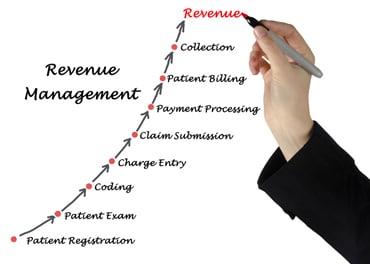In this transitional scenario where the industry is moving from fee-for-service to value-based payment, healthcare providers need novel strategies to optimize reimbursement. The following best practices for revenue cycle management (RCM) can improve accuracy and efficiency and help them get ahead of the game in 2018.
- Improve internal communication: With many physicians working in hospitals and practices, organizations need to improve internal communication, says a recent report from HealthLeaders.com. According to a 2015 study by the American Medical Association (AMA) almost 33% of physicians work directly for a hospital or in a practice with some hospital ownership. This proportion rose 12% in just two years. Management needs to have regular discussions, set goals and practice management models, and identify potential problem areas. This will improve workflow and help early resolution of issues before they get out of hand.
- Track key performance indicators (KPIs): Tracking and reporting key KPI is important to understand how you are progressing toward your short-term and long-term goals. You need to identify and track outcome-based KPIs such as occupancy rate, average length of stay, infection rates, readmission rate, patient wait time, adherence to follow-up, patient to staff ratio, operating margin, claims denial rate, and patient satisfaction. Focus on denial rates as they can directly impact your bottom line. Outsourcing medical billing can help you track your financial KPIs. Share your organization’s revenue cycle KPIs with your team of physicians and build accountability.
- Work on addressing claims denials: Claims are denied for a plethora of reasons. Common issues include lack of coding specificity, missing information in claims, claims not filed on time, coding errors such as upcoding and downcoding, incorrect patient identified information, duplicate billing, and lack of documentation to support medical necessity. Providers need to focus on preventing these issues from occurring.
- Optimize resource use: Conduct a cost-benefits analysis to see which option would be more beneficial for you – doing medical coding in-house or medical coding outsourcing. Starting October 1, 2017, thousands of updated FY 2018 ICD-10 codes went into effect. The CPT 2018 manual contains a total of 172 new codes, 60 revised codes and 82 deletions. Every hospital, physician practice, medical provider, payer billing, abstracting system, and/or encoder must incorporate necessary code changes into their system. On Nov 2, 2017, the Centers for Medicare & Medicaid Services (CMS) released the CY 2018 Medicare Physician Fee Schedule (MPFS) Final Rule as well as the CY 2018 Quality Payment Program Final Rule. These Final Rules contain several important provisions. The support or skilled AAPC-certified coders is vital to understand the changes, submit claim accurately, minimize denials, and ensure proper reimbursement for services provided. With the right team, the chances of getting it right the first time would be greatly improved. Adopting the right strategy to make the best use of resources will help keep your costs low.
- Use technology to manage accounts receivable (AR): A technologically savvy medical billing company can help you utilize advanced billing software to monitor and track your financial performance. With the right partner, you can optimize the use of your practice’s software and prevent revenue leakage. Efficient practice management and medical billing software can streamline your entire collections process.
- Invest in new technology only if it is feasible: A Beckers Hospital Review report advises healthcare organizations to think twice before they invest in advanced technology. Adding technology would be feasible only if it will solve the problem they are trying to solve, says an RCM expert.
- Take steps to improve patient collections: In this age of increasing patient payment responsibility, practitioners need to take steps to improve patient collections. Strategies such as price transparency, varied options for payment such as card-on-file and online payments, and payment plans can help collect patient payments in a timely manner.
- Develop a compliance program: In an environment of complex rules, implementing a compliance program is crucial for all types of medical entities. Areas for compliance include healthcare insurance and billing, diagnosis and procedure coding, medical records release and informed consents, hiring practices, business and medical records retention, confidentiality, patient rights, employee safety, rights and obligations, and environmental concerns.
Successful RCM is much more than advanced software and high-tech tools. It also requires a dedicated well-trained team of coders and billing specialists, efficient processes, and careful monitoring. A reliable medical billing and coding company will work closely with you to scrutinize how your revenue cycle is working, regularly monitor its performance, improve processes at every step, and maximize your reimbursement.




